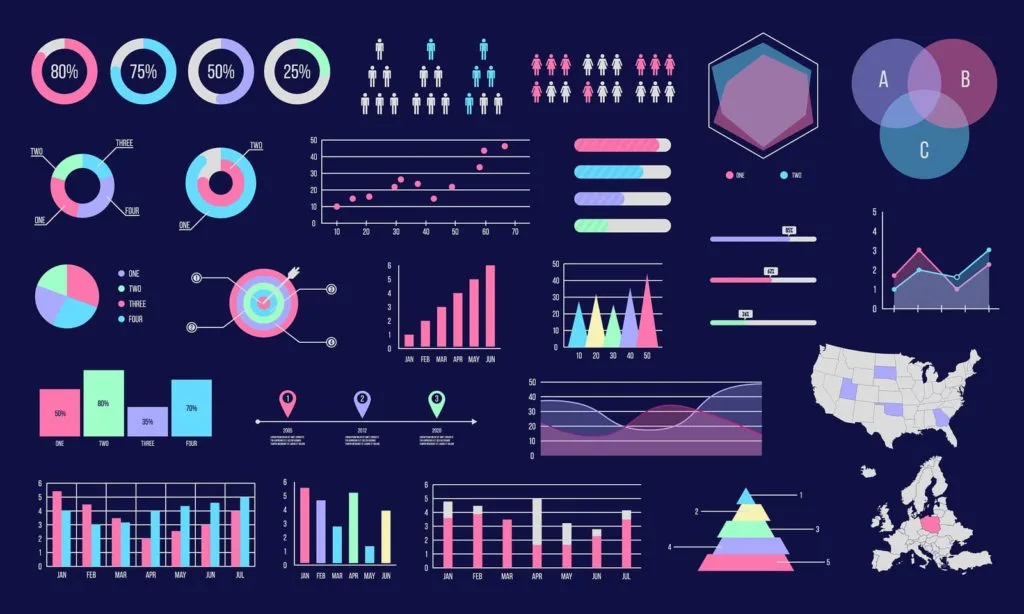OVERVIEW:
Communicating insights through data visualization is not easy, even with the best Business Intelligence Tools at our disposal. Many a times we find ourselves struggling to communicate clear-cut insights. One such use case is Customer or Market Segmentation problems.
Scatter plots are often the go-to visuals in this case. However, they fail miserably if there is a dimension of time involved in the picture i.e. if we want to understand the reaction of our market/customer every time there is a change in a particular attribute. It often becomes impossible for us to generalize the outcome in a statement as we often end up looking at change between two fixed time periods.
For Example: Effect of change in advertisement to market share, effect of change in distribution to sales, etc. can be done using scatter plot but we will be restricting ourselves to look at change in market share/sales between two static points in time – current year vs last year or current month vs last month and so on.
This really does not help us generalize the effect of ad spends on market share and come up with a rule like “Every time Ad Spends are increased by 10% the share for particular market increases by 20%” thus classifying it as a High, Medium, Low, No Responsive markets
Keeping this in mind we have kind of created a template to deal with such classification problems. We will be using Power BI as our BI Tool.
Side note: One can argue that such problems can also be solved using machine learning. True. However, many businesses cautiously prefer to use BI tools because of their easy adoption and interpretability. Though it is absolutely possible to create fully interpretable automated machine learning solutions but we won’t go there in this blog.
BUSINESS PROBLEM:
Understanding Investor Loyalty for an Asset Management Company
Task is to classify its IFAs (Individual Financial Advisor) into 4 quadrants:
- Robust – Investor buys funds even when Sensex Falls
- Volatile – Investor sells funds as soon as Sensex Falls
- Opportunistic – Investor sells funds when Sensex Rises
- Safe – Investor buys funds only when Sensex Rises
Market fluctuation is a relative phenomenon, meaning even at a below average level the market could be considered to be doing better when compared to previous N-days. It is important that the period of comparison be controlled by the user of the report.
Having said so let’s get to the solution
REPORT LAYOUT:
- Axis Filters:
- Units Change %:Let’s us adjust number of bubbles on the Output Visual i.e. clutter or unclutter the visual
- Sensex Change %:Y-axis adjustment of the Output Visual and secondary axis adjustment for Sensex Trend Chart
- Interval Filter:When we talk about change, it’s always relative i.e. it’s always w.r.t last N days. Business users needed the flexibility to look at daily, weekly, bi-monthly, monthly or any arbitrary no. of days as change interval, which is what this filter provides.
- Investor Type:There are multiple investors types in case of a Mutual Funds. Direct, IFA, National, Regional, BND, Alternate. We are not going to go in details of each of them as the investor type that we are interested is the IFAs. Therefore, the filter selection – IFA Distributor
- Sensex Trend: As mentioned earlier an IFA is categorized into any of the 4 categories based on his reactions to market fluctuations. This chart is where we are able to see the latter. The primary axis (line) depicts the Sensex while secondary axis shows the percentage change in Sensex at a given point base on the selected interval (B)
- Investor Selection: Selection filter to focus on any (one or many) IFA. IFAs are sorted descending by their corpus showing the biggest distributors at the top.
- IFA Segmentation: The visual used is Dot Plot by MAQ Software. Y-axis: % change in Sensex (remember percentages are relative and hence based on the selection of the Interval Filter)X-axis: IFAs Bubble Size: % change in the number of units (either bought or sold)Bubble Color: Red – Sold, Green – Bought
Results Interpretation:
- Let’s interpret the visual with an instance. IFA 1226 shows a significant sell out of funds when the market is performing well therefore, he is an Opportunistic Investor.
- Let’s take another example – IFA 147. We can classify him as a Robust Investor because we can see a significant rise in his investment whenever there is a drop in market.
This kind of information is very useful for the sales team and marketing team as they would now know exactly know HOW and WHEN to target an IFA.
This can be used as a Template for Segmentation Problems wherein, we have to classify elements like markets, customer, vendors, employees etc. based on some attributes, especially when one has to look at time-series change of an attribute and when the number of elements to be classified are too many.
Link for the report -> https://tinyurl.com/2uxf2twf
Please Note that the data used in the visualization is dummy data for obvious reasons




